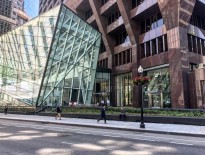Posh suburbs and tony neighborhoods regularly record single-family median sale prices of $1 million or more, while the median sale price in Greater Boston has hit a record $612,000.
Sure, the dearth of new construction and shortage of listings is a major factor driving the relentless rise in prices. But so is something most people don’t necessarily connect with rising home values: Our increasingly gridlocked highways and byways.
The Hub is now officially the worst in the country for grinding bumper-to-bumper commutes according to a survey duly reported by my old employer, the Boston Herald.
But the even bigger story is how those maddening commutes are distorting an already messed up housing market.
All those longer and increasingly frustrating commutes have effectively shrunk the size of the housing market, making entire swaths of the Boston area off limits for all except the most hardened commuters.
Gridlock is shortening the distance buyers find acceptable when considering whether a prospective commute from a new home to work is worth it or not. Buyers are increasingly pushing back against longer commutes, with many looking within a half hour to 45 minute radius from their workplace, brokers say.
Sam Schneiderman, principal broker of the Greater Boston Home Team, noted in an interview last year that the farthest his buyers will stray from the Cambridge or Somerville is Bedford to the west and possibly Brockton to the south.
“Most buyers want a commute that is no longer than about a half-hour,” Schneiderman observed. “Some will settle for 45 minutes if they have to. Very few are willing to commute over 50 to 60 minutes.”
Prices Surge
The preference among buyers for shorter commutes, even if it means buying something smaller, is a trend brokers have been talking about for some time.
And can you blame buyers?
Boston area drivers spent 14 percent of their daily drive in bumper-to bumper-traffic, according to INRIX Global Ranking. That’s higher than New York (13 percent), and L.A. and San Francisco, both at 12 percent. Overall, local commuters spent on average 60 hours a year locked in their cars during peak hours for congestion.
What should be a relatively short, 14-mile commute down the MassPike from Natick to Newton, for example, can easily turn into a 45- to 50-minute grind.
Nor is it just major arteries that are backing up, with suburban centers and secondary roads across the Boston area often gridlocked during rush hour and even on peak times during the weekend.
Back in the 1980s, a commute from an outer suburb on 495 to Boston would have been manageable, a fact that helped spark a mini boom in the small towns along the highway. There was also a functional commuter rail that could get you into city in roughly same amount of time or less at a relatively affordable cost.
But today what was once maybe a 50-minute commute is now far longer and far more grueling. And the formerly reliable commuter rail is a joke, with the Baker Administration’s efforts to turn around the beleaguered system likely to take years to come to fruition.
The overall effect of our traffic-jammed roads and dysfunctional rail lines has been to collapse the universe of options for too many homebuyers to within the 128 beltway, if that. This, in turn, has put additional pressure on scarce listings and inventory, especially in Somerville and Cambridge, as well as inner suburbs like Medford and Watertown.
The result has been surging prices in the inner suburbs and along 128 in Needham, Wellesley and Weston, while towns out on 495 are still struggling to get back to where they were during the last pricing peak a decade ago.
Developers know the score. While it’s still far from the levels needed to put a dent in prices, the stuff that is getting built is largely within the 128 beltway, the inner suburbs and Boston, whether it be McMansions built atop teardowns, luxury condominium high rises or new apartments.
On Beacon Hill, the few proposals with any legs aimed at bringing down home prices and rents have focused on spurring new construction in city and suburb alike. But if buyers are limited by fears of nightmare commutes to a 10- to 15-mile radius in their search for a new home, then it won’t matter how much residential friendly zoning Marlborough or Hopkinton votes through.
Want to restore some sanity to our crazed housing market? Then it’s time to spend the money needed to fix the T and to expand and repair our aging and clogged roadways.
You can go ahead and build it, but the buyers won’t come if they can’t get there.
Scott Van Voorhis is Banker & Tradesman’s columnist; opinions expressed are his own. He may be reached at sbvanvoorhis@hotmail.com.




 |
| 




